
Surrealism Swept Mid-Century America
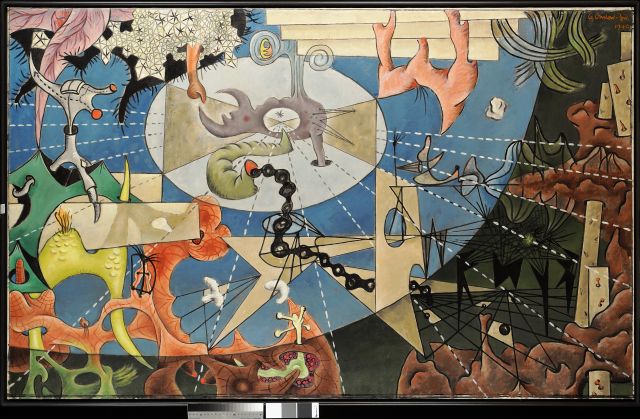 |
|
|
Artists calling themselves 'Surrealists' burst viewers' brains in Paris and other urban centers in Europe in the 1920s. But by the 1940s much of the action had moved to the United States, as artists fled from the Nazis, bringing with them their art.
Soon the public was looking at paintings like 'Propaganda for Love,' filled with squiggles, dashed perspective lines creating a suggestion of infinite space, bird claws, biomorphic forms, pure egg shapes, and – is that a large intestine?
The British painter of this 1942 canvas, Gordon Onslow Ford, helped recruit American artists to the cause of Surrealism by delivering a well-attended lecture on the topic in New York in 1941. Among attendees was Jackson Pollock, whose drip style of action painting was indebted to Surreal automatism.
Onslow Ford would later live in the Bay Area in a modern house designed by Warren Callister and would become part of the Bohemian Sausalito ferryboat scene, which Joe Eichler’s architect Bob Anshen also joined.
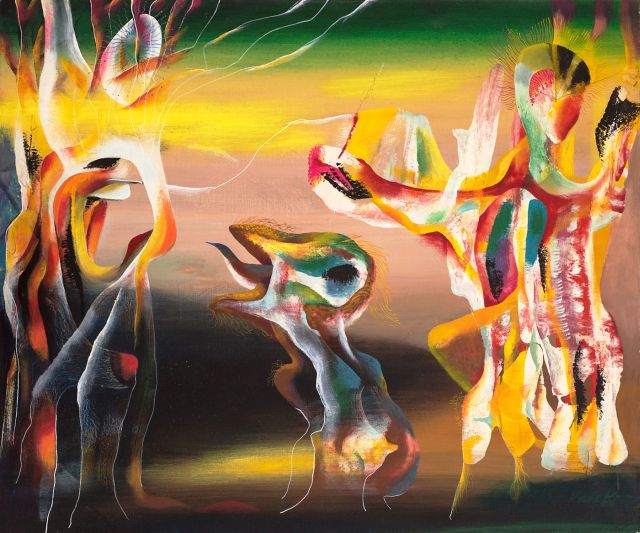 |
|
|
Onslow Ford’s wife, Jacqueline Johnson, had another important tie to modern architecture in Northern California. She commissioned Richard Neutra to design a small house for herself in the late 1930s. This house was later preserved, moved, altered, and exists today as the Neutra House, an event venue in Los Altos.
The Napa Valley Museum is showing a wonderful exhibit that focuses on these years and beyond. 'The Surrealist Revolution in America' continues through October 27. Info-packed without being pedantic, the show is arranged almost like a series of one-person shows, focusing on European artists who worked in the United States, as well as artists from here.
The exhibit was organized with the Weinstein Gallery in San Francisco, which focuses on work of this era and type. (No relation to the author of this blog.)
Large wall panels provide lively tales, including how Kurt Seligmann, who arrived on our shores in 1939, helped other artists flee what for many would have been sure death. The horrors of the war affected much of the art that we see here.
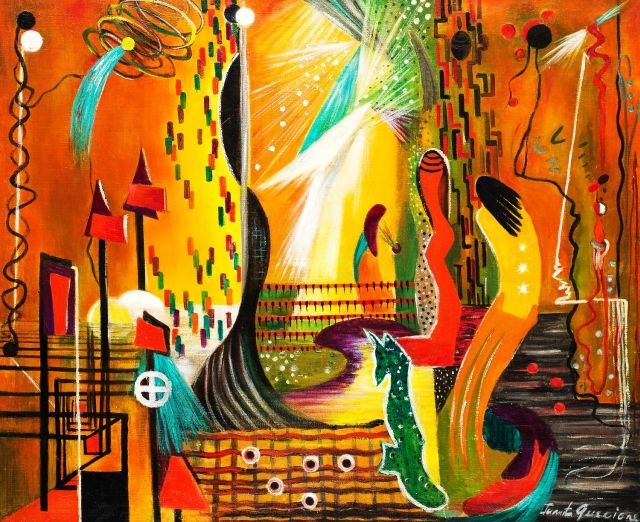 |
|
|
If you get to this show, do not forget about the downstairs gallery, which features an amazing collection of flamboyant, dreamlike paintings by Juanita Guccione (1904-1999). The museum says this is "the first comprehensive exhibition" of her work.
Resurrecting the work of women artists who have been passed over by time proves a winner here. Her best paintings – landscapes abstract or cosmological, seashore scenes with horses, mystical eyes in sunbursts – suggest naiveté, but just bubble with life and exuberant design.
And don’t neglect to read about her life, which was as colorful as her paintings.
Among the marvels in the Napa exhibit is a 'The Appetite of a Bird' by another artist you have probably never heard of, Gerome Kamrowski. It’s got that charming, creatures-emerging-from-the mist look common to much Surrealist work.
Also shown is something completely different – a single, small abstraction done by three artists, Kamrowski, William Baziotes, and Pollock, an example of free association in paint.
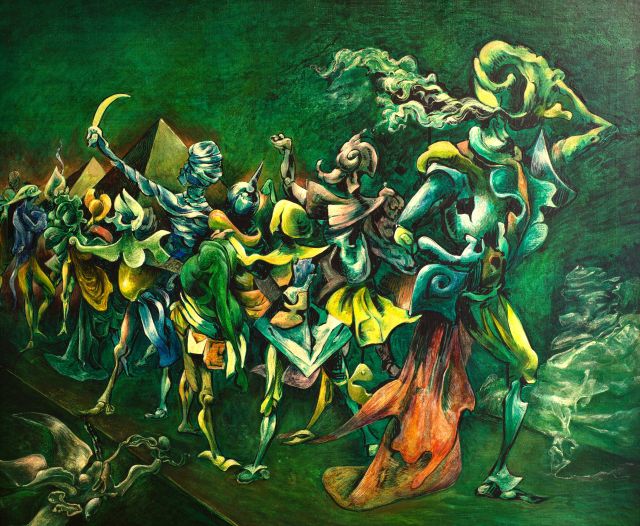 |
|
|
Seligmann’s work is enjoyable too, as he developed what he called 'cyclonic landscapes' inspired by the Grand Canyon and other such Southwestern scenery.
Sections are also devoted to work by sculptor David Hare, Jimmy Ernst, Enrico Donati, and others.
At BAMPFA (the Berkeley Art Museum), meanwhile, a sprawling exhibit entitled 'Strange' draws from the museum’s well-stocked collection to present artwork “that resonate with the spirit of Surrealism.”
Surrealism, after all, was an actual movement that had official members – with a leader who could excommunicate those deemed disloyal.
'Strange' plays with a freer hand, dipping into 17th century India for the charming painting 'Churning the Sea of Milk,' and jumping to contemporary times for wonderful and mysterious drawings by Jim Shaw from the 1990s.
From Sylvia Fein, who lives in Martinez in the East Bay and is celebrating her 100th year, we have a classic, mystical Surrealist image, 'Crucial Eye,' an immense eye, floating in space yet tethered, staring at us as we stare at it. She was once part of the homegrown 'Surrealists of the Midwest.'
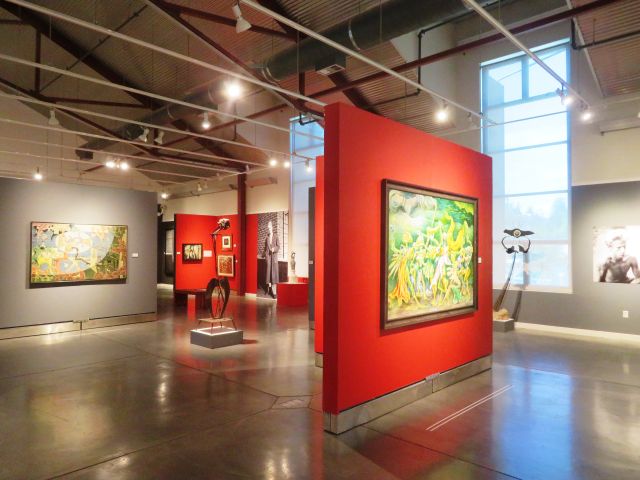 |
|
|
Was the East Bay’s favorite Arts & Crafts architect, Bernard Maybeck, a Surrealist before the fact? A spooky watercolor circa 1915 with gnarled oaks, a courtyard, and a hunched creature suggests yes.
Much work of artists who came of age late in the 20th century also suggests that the appeal of dreamlike states still resonates even in an artistic age that celebrates cool, the minimal, the political, the conceptual.
Drink in an entire wall of drawings done collaboratively, and by mail, by artists Daniel Higgs and Kyle Ranson from 2007-2011. Toadstools with eyeballs, mountains with tongues, faces made up of flowers, grapes and snakes.
'The Surrealist Revolution in America' runs through October 27 at the Napa Valley Museum, 55 Presidents Circle, Yountville. 'Strange' remains at BAMPFA, 2155 Center Street, Berkeley, through January 19, 2020.
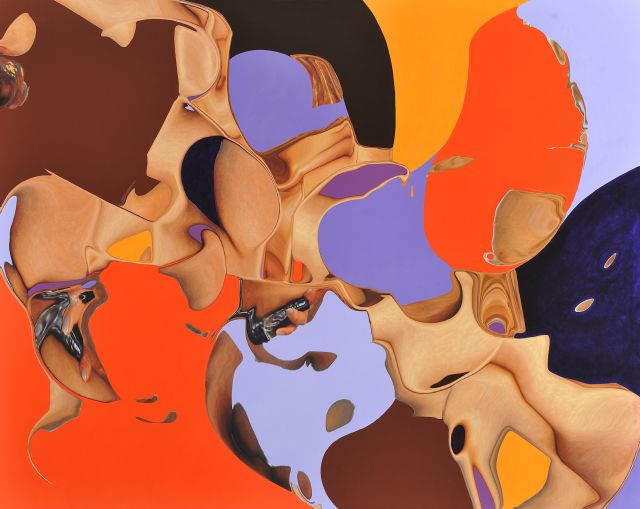 |
|
|
- ‹ previous
- 551 of 677
- next ›



